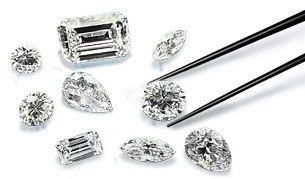The least important diamond grade is clarity. Unfortunately, it is what many jewelers claim is most important, because it is the easiest to demonstrate. Anyone can put a diamond under a microscope and see if it has inclusions. It takes gemological knowledge to cut and/or color grade a diamond. Jewelry merchants with little or no formal gemology training often resort to a quick demonstration of clarity, which has made it the most important grade to many consumers. This could not be further from the truth.

|
By definition, any grade diamond of SI2 and above requires magnification to see the inclusion. How often do your friends look at your diamond under a loupe? Since any diamond of SI2 clarity and up is considered "eye clean," meaning you must have magnification to see any inclusion, why worry about clarity above the SI2 range? Of course, if you are told you are getting a VS1 you want make sure you actually are. But you can save lots of money by buying a diamond that is well proportioned, with good color, but is in the SI1 or SI2 clarity range. To put it another way, a perfectly cut diamond of D color and SI2 clarity will look the same to everyone around you as a perfectly cut diamond of D color VS1. However, the SI2 diamond could save you thousands of dollars.
Explanation About Each Clarity Grade
Below is a breakdown of the diamond clarity grading scale. Be aware that these are only used to demonstrate the general level of inclusions that qualify a diamond to fall into any one grade. The study of diamond clarity is lengthy and involves many types of inclusions. Please note that the red colors indicate internal features, while green colors indicate surface or surface breaking features.
Plumber Rio Linda
















